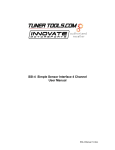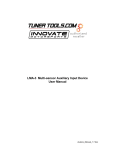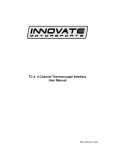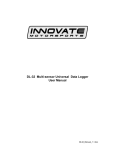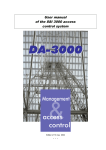Download SSI-4 Simple Sensor Interface 4 Channel User Manual
Transcript
SSI-4 Simple Sensor Interface 4 Channel User Manual SSI-4 Manual 1.2.doc 1. Overview ............................................................................................................................... 3 Differential Inputs .............................................................................................................. 4 2. Specifications........................................................................................................................ 4 The Innovate Log-Chain concept .................................................................................................... 5 2.1 Log-Chain of 4 channels consisting of SSI-4 alone.......................................................... 6 2.2 6-channel Log-Chain example with 2 AFR channels........................................................ 6 2.3 16-Channel Log-Chain example ....................................................................................... 6 3. Connecting the SSI-4............................................................................................................ 7 3.1 Connecting power ............................................................................................................. 7 3.2 Connecting external sensor signals.................................................................................. 7 3.3 Powering external sensors................................................................................................ 7 4. RPM measurement............................................................................................................... 8 4.1 RPM Measurement basics................................................................................................ 8 4.1.1 Four-Stroke Engines.................................................................................................. 8 4.1.2 Two-Stroke Engines .................................................................................................. 8 4.1.3 Rotary Engines (Wankel Engine) .............................................................................. 9 4.2 How the SSI-4 determines RPM ....................................................................................... 9 4.2.1 Measurement Method on Channel 1 ......................................................................... 9 4.3 Connecting an RPM signal (Channel 1) ........................................................................... 9 5. Measuring Frequencies, custom RPM, or speed ............................................................... 10 6. Measuring duty cycle .......................................................................................................... 10 7. Measuring external 5V sensors .......................................................................................... 11 8. Programming the SSI-4 with LM Programmer ................................................................... 11 8.1 Changing the device name ............................................................................................. 12 8.2 Updating the firmware ..................................................................................................... 12 8.3 Input Configurations ....................................................................................................... 12 8.3.1 Measuring RPM (Input 1 only) ................................................................................. 12 8.3.2 Measuring Frequency (all Inputs) ............................................................................ 13 8.3.3 Measuring Speed (all Inputs)................................................................................... 13 8.3.4 Measuring Duty Cycle (Input 2 only) ....................................................................... 14 9. Kit Contents ........................................................................................................................ 15 Appendix A: Limited Warranty ...................................................................................................... 16 Revision History............................................................................................................................. 16 1.1 -2- 1. Overview The SSI-4 device is a simple sensor interface device to add 4 inputs to an MTS Log Chain. The SSI-4 may also be used as a stand-alone 4 channel MTS compatible input device (see Chapter 2 for more details). Each of the four inputs of the SSI-4 can be user configured for different functionalities. The following tables show the functionality of each of the 4 inputs of the SSI-4 (the default factory settings of the SSI-4 are highlighted: Input Function 1 Function 2 Function 3 Channel 1 Frequency (straight frequency, Speed sensor) External 0..5 Volt Channel 2 RPM (programmable Range, default 0..10230 RPM, 4 Cylinder) Duty Cycle External 0..5 Volt Channel 3 N/A Frequency (straight frequency, Speed sensor) Frequency (straight frequency, Speed sensor) Frequency (straight frequency, Speed sensor) Channel 4 External 0..5 Volt External 0..5 Volt The SSI-4 also can act as a power supply for user supplied external sensors. The 5V output of the SSI-4 can supply up to 300mA of current. -3- 1.1 Differential Inputs The SSI-4’s external connections are differential. This means that each input channel has 2 input terminals. A + terminal and a – terminal. This is to eliminate ground offsets in the signal. Many times the ground point of a sensor is at a different ground than the SSI-4. Because an electronic device can only measure a voltage referenced to it’s own ground, differences in grounding can introduce measurement errors. The SSI-4 measures the sensor signal’s ground with the – input and them measures the difference between the + and the – input. This way it “recreates” the sensor signal’s own ground reference as if this input were referenced directly to that sensor’s ground. The common mode rejection range is the maximum voltage this ground reference input can differ from the SSI-4 ground. The (–) input is NOT a ground itself. It is a ground reference input. 2. Specifications Power Power requirements Power reversal protection External Sensor power 8-36 Volt / 50mA 1 Yes 5V (+- 2.5%), 300mA max. Serial Communication Serial Port Speed Packet/Logging Speed Sample Resolution 19.2 kbit/sec 81.92 msec/sample packet 10 bits (0..5V at 0.1% resolution) Input Specifications Number of Channels Input measurement range CHx+ max input voltages CHx- max input voltages Common Mode Rejection Range Input threshhold for pulsed Signals Max Frequency Input Impedance 4 0..5V - 22.5 Volt to +300 Volt - 22.5 Volt to +27.5 Volt -22.5 Volt to +22.5 Volt 2.5V 15 kHz2 1 MOhm Temperature Max Operating Temperature -20 to +80 deg Celsius Mechanical Size (W x L x H) Weight 133 x 65 x 26 mm 114 grams Note 1: Supply current specified does not include external sensor current supplied by 5V output. Note 2: Sum of all frequency/Duty Cycle signals connected should not exceed 15 kHz. -4- The Innovate Log-Chain concept LogWorks 2.0 has the capability to log, display and analyze up to 32 engine parameters. Most users will use less though. Each of the MTS components reads between 1 and 6 engine parameters. To interface a multitude of MTS components to LogWorks with a single connection, the Innovate LogChain concept was introduced. The SSI-4 can be used as a MTS component in a Log-Chain. Each of the MTS components has two serial ports (except the LM-1, which has only one). One serial port is designated as IN-port, the other as OUT port. The OUT-port of one device is connected to the IN-port of the next device and so on. This way devices can be ‘daisy-chained’ to build a log-chain for up to 32 channels total. The OUT-port of the last device is connected to the computer for logging or downloading of logged data. The device that’s first in the chain is special. It determines the logging sample rate. The first device in the chain sends a data packet containing its channel data (a sample) to the next device (downstream, left to right in the diagram) every 81.92 milliseconds. The next device appends its data to that packet and hands that packet to the next device downstream and so on. At each device the packet grows in length. The devices in the chain synchronize their sampling of the engine parameters to the packets, so that all the channels in a packet together represent the same instance in time. At the downstream end of the log chain (OUT-port of the last device) a computer or external logger can be connected to store or display the stream data. The XD-1 display is such a device. This also means that the complete channel data set is ONLY available at the end of the log-chain. A datalogger capable of recording the log-chain data-stream therefore MUST be placed at the end of the log-chain. This includes lap-top computers or other loggers. Commands for individual devices are sent ‘upstream’. A device (incl. a computer or an XD-1) can send commands to the devices upstream of itself, but not downstream. Commands can include start-stop recording, calibration/configuration commands and so on. Only the device directly upstream of the command originator of course will receive the command. This device then decides, depending on the command, whether to execute the command and whether to pass it on. An example of a case where the command is executed but not passed on is the start-stop record command. The first upstream device capable of logging internally will execute the command, but not pass it on. As said before, the first device is special because it is the synchronization source for the entire chain. By plugging its IN-port with the supplied terminator connector, a device can detect that requirement when it powers up. The terminator connector just connects the transmit and receive line of the IN-port together. Each device sends a special command out on it’s IN port when it powers up. This command is ignored and not passed on by any device if received on it’s OUT port. If the sending device immediately receives that command on its IN-port again, because the terminator is plugged in, it assumes it is the first and special device in the chain. The LM-1, having only one serial port, is ALWAYS a special device and MUST be connected to the beginning of the chain. The following are some examples of Log-Chains using the SSI-4 and other MTS devices. NOTE: The SSI-4 does NOT need a terminator plug on it’s IN port. It automatically detects if another device is plugged into it’s IN port and terminates the IN port if nothing is plugged in. -5- 2.1 Log-Chain of 4 channels consisting of SSI-4 alone. 2.2 6-channel Log-Chain example with 2 AFR channels. Notice that the LC-1’s are connected BEFORE the first SSI-4. LC-1’s should always be connected before the first SSI-4. 2.3 16-Channel Log-Chain example The example chain consists of a LM-1/LMA-2, a LC-1, a SSI-4, a LMA-3 and 2 XD-1’s. In this case the chain has 16 channels (6 from LM-1, 1 from LC-1, 4 from the SSI-4 and 5 from the LMA3). Devices attached to the LM-1’s analog input count as being part of the LM-1’s 6 channels. They don’t count extra. XD-1’s do not contribute any channels, so you can add as many as needed. -6- 3. Connecting the SSI-4 The SSI-4 looks like this: 3.1 Connecting power Connect switched 12V power (switched on when the cars ignition system is on) from the car to the terminal marked 12V on the SSI-4 connector. Connect one of the terminals marked GND to a good ground on the car. The engine block will supply a good ground connection. 3.2 Connecting external sensor signals For each external connection you can connect the external sensor’s output to the CHx+ connection. Connect the CHx- connection to the ground of the sensor. Make sure the sensor output signal does not exceed 5V. The SSI-4 is protected if sensor signals exceed that (up to 300V for most inputs), but it cannot measure beyond a 5V signal. 3.3 Powering external sensors At the connection marked 5V you can connect external sensors. External sensors don’t HAVE to be powered by the SSI-4. The 5V output is a convenience for external sensors when no 5V supply is available. The 5V supply can power sensors with a total power consumption of up to 300mA. -7- 4. RPM measurement 4.1 RPM Measurement basics Most RPM measurement methods use the ignition system of the car as a convenient source of RPM dependent pulses. Other methods use a TDC sensor (one pulse per rotation), cam sensor, or fuel injection pulses (number of pulses/rotation is dependent on the fuel-injection system). Some actually measure the AC frequency created by the car's alternator. Because the number of pulses per crank rotation is dependent on the ignition system and engine type, a universal RPM measurement method must be adaptable to the different environments encountered. The typical ignition system consists of an ignition coil, a coil driver that switches current to the coil on and off, and a distributor. When current is switched on to the coil, the coil stores energy in its magnetic field. When the current is switched off, that energy gets discharged at a very high voltage pulse on the coil’s secondary winding, creating a spark. A capacitive discharge ignition system (CDI) uses a capacitor to store the spark energy. The capacitor is charged to about 400V and then rapidly discharged over the ignition coil's primary winding. The coil thus only acts as transformer and does not store energy (and can therefore be smaller). The advantage of a CDI system is a very high and fast rising spark voltage (less susceptible to spark fouling). The weakness of the CDI system is the very short duration spark, which might not be long enough to ignite the mixture. Multispark ignition systems try to overcome the inherent weakness by creating multiple spark pulses over some degrees of crank rotation to increase the likelihood of igniting the mixture. The distributor switches the spark voltage to the appropriate spark plug. 4.1.1 Four-Stroke Engines On a typical 4-stroke engine each spark plug fires once for every two crank rotations. The coil on a distributor-equipped 4-stroke has to create sparks for every cylinder. The number of ignition pulses per crank rotation in this case is the number of cylinders divided by 2. Some engines have one coil for every 2 cylinders instead of a distributor. The coil fires two spark plugs at the same time. One spark is wasted because it fires one cylinder at the end of its exhaust stroke. Therefore, this system is called a Waste Spark System. Each coil of a Waste Spark System fires once for every crank revolution. Other distributor-less 4-stroke engines use one ignition coil for every spark plug. This ignition system fires each coil once for every 2 crank revolutions. Coil-on-Plug ignition systems actually incorporate the ignition coil in a module that plugs directly onto a spark plug and do not have a spark plug wire. 4.1.2 Two-Stroke Engines On a 2-stroke engine there is a spark for every crank rotation, so the spark frequency doubles compared to a 4-stroke.Very few multi-cylinder 2-strokes have distributors. For those that do, the number of ignition pulses per crank rotation is equal to the number of cylinders. Most two-stroke engines have one coil for every cylinder. The coil fires once for every crank revolution, the same as on a 4-Stroke Waste Spark system. -8- 4.1.3 Rotary Engines (Wankel Engine) A rotary engine consists of a roughly triangle shaped rotor rotating in a roughly elliptical chamber. The three spaces left between the chamber and the rotor go through the four cycles of a fourstroke engine for each rotation of the rotor. A single (or dual) spark plug at a fixed position in the chamber ignites the mixture of each space in sequence. Therefore, a rotary engine requires 3 sparks for every rotation of the rotor. The mechanical power from the rotor is coupled to an eccentric gear to the output shaft. This gear has a 3:1 gear ratio and the output shaft therefore rotates 3 times faster than the rotor. The output shaft is the equivalent of the crankshaft on a piston engine. Because RPMs are measured conventionally as the rotations of the crankshaft, the rotary engine requires one spark for every 'crankshaft' rotation, the same as a two-stroke engine. 4.2 How the SSI-4 determines RPM 4.2.1 Measurement Method on Channel 1 The SSI-4 measures RPM not by measuring the number of pulses over a time period, as a tachometer does. That measurement would be too slow to provide adequate correlation between input channels. Instead the SSI-4 measures the time between input pulses and from that calculates RPM for each pulse measurement. This measurement method has a few caveats though: 1. If the RPM pulse signal is derived from the ignition signal, a multi-spark ignition system will trigger the measurement multiple times for each pulse. This throws the measurement off because the SSI-4 does not know if the pulses are for each ignition event (one per cylinder cycle) or because of multispark. This is specially problematic because the number of multispark pulses also varies with RPM in a lot of ignition systems. Fortunately many multispark ignition systems output a tach signal with only one pulse per engine cycle. But some, notably Ford EDIS systems, output all pulses and therefore may require a special tach adapter. 2. Odd fire engines, like V-Twin motorcycle engines and odd-fire V6 engines have ignition pulses that are not evenly spaced. For example a 60 degree V-Twin running at 10 degrees ignition advance will fire cyl. 1 at 10 degrees BTDC. Then fire cyl. Two 420 degrees later at 410 degrees. Then fire cyl 1 300 degrees later at 710 degrees. This means the ignition pulses sent to the SSI-4 are alternating between 420 and 300 degrees apart and therefore the time between pulses alternates. The SSI-4 therefore measures the times between ALL pulses for a complete engine cycle (2 rotations) and averages the times between them. 4.3 Connecting an RPM signal (Channel 1) - Connect the RPM signal to the CH1+ input screw terminal. Connect the CH1- signal to the ground of the RPM signal source. For example the ground of the ignition system at the ignition box, not where it’s ground wire connects to the frame or engine. -9- 5. Measuring Frequencies, custom RPM, or speed The SSI-4 has the capability to measure frequencies on any of the channels. It converts a frequency signal (pulses per second) into a number between 0 and 1023 (or 0..5V) to be logged directly by LogWorks. This is useful for measuring custom RPM ranges, signals from speed sensors or the frequency of MAF sensors with frequency output (as opposed to voltage output MAF sensors). The range of frequencies that the SSI-4 can measure can be programmed by with LM Programmer. The SSI-4 can be set to any frequency range between 0 and 30 Hz for the full 0..5V range to 0..15 kHz for the full 0..5V output (logging) range. Also, LM Programmer has convenient conversions built in, so you don’t have to calculate the resulting frequency ranges for speed sensing or RPM sensing yourself. See chapter 10.x for details. A frequency input signal must have an amplitude (voltage range of pulse) between 0.5V at the low pulse point to minimum of 3V and maximum of 40 V at the high pulse range. See chapter 10 for details on different kinds of Frequency, speed and RPM sensors. NOTE: The custom RPM feature will work only for even fire tach signals, not for tach signals that vary their time between pulses during an engine cycle (odd fire engines). Use the input 1 RPM functions instead. 6. Measuring duty cycle To measure the duty cycle of a signal in channel 2, the input signal must cover the same voltage range as for a frequency signal. Duty cycle is defined as the ratio between the time a signal is active and the total time of the active and inactive time. A signal can be either active high ( the event, like injector open, happens when there is a high voltage) or active low (the event happes when the measured signal is at ground or close to it). Very often the injector duty cycle is to be measured by the SSI-4. A typical fuel injector is connected to 12V on one side, while the other side is connected to ground when the ECU opens the injector. Because the pulse is therefore active when the voltage on the pin is at ground, negative duty cycle is measured. So called peak-hold injectors (as opposed to saturated injectors), work differently. Their drive signal first goes to ground for a high current opening pulse, then rises to 8-10 Volts for the hold period. Because the SSI-4 sees everything above 2.5V as “high”, it will be able to see only the peak period. On some peak-hold systems it is possible to connect the CHx+ input of the SSI-4 to 12V at the injector and connect the CHx- input to the injector signal to still measure correctly. If the above method can be applied, it actually measures positive duty cycle. But that is not always the case. The LogWorks 2.0 Manual shows an alternative method. - 10 - 7. Measuring external 5V sensors Each of the 5 channels on the SSI-4 can be configured to accept input from an external 0..5V sensor. Hookup is very straight forward, with ground going to the ‘-‘ input for the channel and the positive sensor signal going to the ‘+’ input for the channel. Raw sensor data can be converted into meaningful units and values using the input configuration features of LogWorks on a PC. 8. Programming the SSI-4 with LM Programmer To connect the SSI-4 for programming follow these steps: 1. Disconnect any MTS device from the IN port. 2. Connect the 2.5mm to DB 2 computer interface cable into the Serial OUT port. Your computer needs a serial port. If it does not have one, you will need a USB to serial adapter. 3. Power the SSI-4 either from 12V or a 9V Battery (when using a desktop computer). 4. Start the LM Programmer application The following screen will show up: The LM Programmer software then shows in its first page the type and version number of the firmware of the device. - 11 - 8.1 Changing the device name If multiple SSI-4’s are used in a Log-Chain, each MUST be given a unique name so that LogWorks can identify each SSI-4. Just enter a name in the edit box in this page. 8.2 Updating the firmware Click on the ‘Update Firmware’ button. You will be presented with a file dialog box that allows you to select a firmware file. Firmware files end with the file extension .dld. SSI-4 firmware file names start with: SSI4. The first part is followed by a dash, then a V, then the version number without dots. Example: SSI-4 firmware version 1.00 alpha release would have the file name SSI4-V100A.dld SSI4 firmware version 1.00 would have the file name SSI4-V100.dld After you opened the firmware file, this new firmware will be downloaded in the SSI-4 device. 8.3 Input Configurations Click on the appropriate Input tab in the top of the window to configure one of the SSI-4 inputs.. Each Input has different capabilities. Below are details for the setup of each capability. 8.3.1 Measuring RPM (Input 1 only) The drop-down list at the top of the window allows you to select the different functionality for that input. If RPM is selected, the area below the functionality selection shows as above. - 12 - Select the cylinder count in the appropriate drop-down list. On the left edit box you can specify the max RPM for this measurement channel. In the example case the max RPM is 6000. This means that in LogWorks 6000 RPM is equivalent to 5Volt. This allows LogWorks to have a higher RPM resolution (~ 6 RPM per step instead of 10 RPM when the range is 0..10230 RPM). This functionality is also available for Inputs 4 and 5. 8.3.2 Measuring Frequency (all Inputs) The center section of the window changes to this: You can enter any frequency between 10 Hz and 15000 Hz as full scale frequency. SSI-4 measures the frequency with a resolution of 0.1 % of the full scale frequency specified. So in LogWorks 0 Hz is always 0 Volt, and the full-scale frequency is equivalent to 5 Volt. This functionality is also available for Inputs 4 and 5. 8.3.3 Measuring Speed (all Inputs) Select the Speed sensing function in the topmost drop-down list. The center section of the window changes to: With the radio buttons you can select to use metric (km/h) or US (mph) units. In the left dropdown list you select the max speed to be measured. The SSI-4 measures the speed with a resolution of 0.1 % of the selected max speed. - 13 - In the right edit box you enter the pulses per mile the speed sensor produces. Speed sensors are typically pulse sensors mounted either on the drive-shaft or wheel. To calculate the pulses per mile (or km/h) click on the calculate button: Select if you use a drive-shaft sensor or a wheel sensor. Enter the pulses per rotation created by the sensor either as driveshaft rotation or wheel rotation. You also need to enter the wheel diameter, and in case of a drive-shaft sensor, the final drive (differential) ratio. The LM-Programmer will calculate the pulses per mile (km) for you. This functionality is also available for Inputs 4 and 5. 8.3.4 Measuring Duty Cycle (Input 2 only) Input 2 has the capability to measure duty cycle. See chapter 7 for details. - 14 - 9. Kit Contents SSI-4 kit P/N: 3783 SSI-4 Program Cable P/N: 3746 Software CD (Includes Instructions) Terminal Block & Hardware Kit Daisy-Chain Cable P/N: 3760 - 15 - Appendix A: Limited Warranty LIMITED WARRANTY Innovate stands behind the quality of its products. Innovate makes the following warranty to purchasers of its products: All new Innovate products carry a six-month warranty from the date of purchase. If proof of purchase cannot be provided, warranty will be determined by date of manufacture. When Warranty Void This warranty shall terminate and Innovate shall have no obligation pursuant to it if (i) your Innovate product has been modified or repaired in a manner not previously authorized by Innovate in writing, (ii) the identification markings on your Innovate product have been removed, defaced, or altered; (iii) your Innovate product was subjected to accident, abuse, shipping damage, or improper use; (iv) your Innovate product was not used or configured as specified in the product manual; or (v) your Innovate product was subjected to operating conditions more severe than those specified in the product manual. Exclusions From This Warranty Oxygen Sensors are excluded from this warranty. Repairs Under This Warranty In the unlikely event that your Innovate hardware product should prove defective during the warranty period, contact Innovate Customer Support for a return material authorization (RMA) at 949-502-8400. Products returned for service must be securely packed to prevent damage and shipped charges pre paid, along with proof of purchase and the return material authorization number, to the Innovate repair location as instructed by Customer Service. Innovate within a reasonable amount of time from its receipt of your product so shipped, will ship to you, at its option, the repaired product or a new or reconditioned product of comparable or greater specified functionality. All repaired or replacement products shall be warranted for the remainder of the original product warranty. Disclaimer INNOVATE MAKES NO OTHER EXPRESS OR IMPLIED WARRANTY WITH RESPECT TO YOUR INNOVATE PRODUCT OTHER THAN THE LIMITED WARRANTY SET FORTH ABOVE. No Innovate dealer, agent, or employee is authorized to make any modification, extension, or addition to this warranty, unless enforceable or unlawful under applicable law, INNOVATE DISCLAIMS ALL IMPLIED WARRANTIES, INCLUDING THE IMPLIED WARRANTIES OF MERCHANTABILITY, NONINFRINGEMENT, AND FITNESS FOR A PARTICULAR PURPOSE, AND THE LIABILITY OF INNOVATE, IF ANY, FOR DAMAGES RELATING TO ANY ALLEGEDLY DEFECTIVE PRODUCT SHALL UNDER ANY TORT, CONTRACT, OR OTHER LEGAL THEORY BE LIMITED TO THE ACTUAL PRICE PAID FOR SUCH PRODUCT AND SHALL IN NO EVENT INCLUDE INCIDENTAL, CONSEQUENTIAL, SPECIAL, OR INDIRECT DAMAGES OF ANY KIND EVEN IF INNOVATE IS AWARE OF THE POSSIBILITY OF SUCH DAMAGES. Some states do not allow limitations on how long an implied warranty lasts or the exclusion or limitation of incidental or consequential damages, so the above limitations or exclusions may not apply to you. Revision History 1.0 6/27/06 Initial Release 1.1 9/15/07 Add Kit Contents 1.2 12/01/08 Removed unsupported functions - 16 -
















